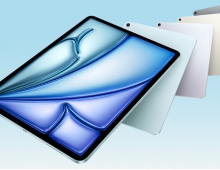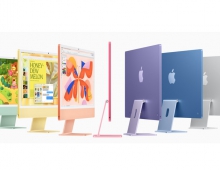
Apple To Rely on Displays for Future Innovation
Apple has been an early adaptor of display technology in order to have an edge over competition. Although the company's leadership in display adoption has been challenged, it is believed that Apple is planning to revamp nearly all of the displays in its products over the next year.
Apple has been an early adaptor of display technology as well as a critical part of the supply chain - rather than relying on display and materials makers to develop the most advanced displays, the company has invested in the supply chain and intervened in the technical direction of its displays. It is clear from its products that Apple is a strong believer in high resolution, wide color gamut and wide viewing angle displays. Apple has several "firsts" in its record: first to adopt a display with more than 300 ppi in a smart phone; first to adopt QXGA resolution in a tablet PC; first to integrate cover glass into product design; and of course, first to integrate touch sensor into the display (in-cell touch).
However, rapid developments in technology and manufacturing of LCD and OLED displays have challenged Apple?s leadership in display adoption. Apple is no longer able to offer unique features in its displays as a long-term differentiator. Mobile device brands are adopting the latest displays with large sizes, high resolution, wide color gamut and low color shift wide viewing angle, and low power consumption, supplied by many panel makers not "bounded" by Apple. Introduction of the iPhone 5S and 5C was the latest example that Apple has been slow in adopting the latest display technologies. While 5-6" FHD resolution displays are rapidly growing in the smart phone market, the iPhone has stayed with the 4" 1136x640 screen for over a year and a half. In tablet PCs as well, Apple was once the initiator of advanced displays, but now has become a follower.
Based on supply chain research, David Hsieh Vice President, Greater China Market for DisplaySearch, believes Apple is planning to revamp nearly all of the displays in its products over the next year. Hsieh speculates about Apple?s new products and claims that the iPhone 6 will have a 4.7" 1280?720 and a 5.7" 1920?1080 display; the new iPad will have 12.9" 2732?2048 screen and; the iPad mini 2 will have a 7.9" 2048?1536, portrait mode:
In reality, changing to a bigger display or a higher resolution is not as simple as changing the screen. The graphic processing unit (GPU) and operating system match the display hardware. A device with high resolution screen but without high-resolution GPU and OS capabilities is like a soldier driving a powerful tank but using a sword to fight. What Apple does better than any company is integrate the hardware and software, as well as the implementation of the user interface, and finally the content ecosystem.
Apple's competitors, led by Samsung with its Galaxy series, have been rapidly adopting higher-spec displays. The Galaxy S-IV and Galaxy Note III have full HD (1920x1080) AMOLED displays, 5" and 5.7," respectively, and there are indications that that a future Galaxy Note will have a flexible AMOLED. Samsung is also expected to release a new Galaxy Tab with a higher than 10" AMOLED screen. Meanwhile, other smart phone brands like hTC, Huawei, Nokia and Sony are all gearing up with higher resolution, larger displays, as are the tablet PC makers, led by Google and Amazon.
However, rapid developments in technology and manufacturing of LCD and OLED displays have challenged Apple?s leadership in display adoption. Apple is no longer able to offer unique features in its displays as a long-term differentiator. Mobile device brands are adopting the latest displays with large sizes, high resolution, wide color gamut and low color shift wide viewing angle, and low power consumption, supplied by many panel makers not "bounded" by Apple. Introduction of the iPhone 5S and 5C was the latest example that Apple has been slow in adopting the latest display technologies. While 5-6" FHD resolution displays are rapidly growing in the smart phone market, the iPhone has stayed with the 4" 1136x640 screen for over a year and a half. In tablet PCs as well, Apple was once the initiator of advanced displays, but now has become a follower.
Based on supply chain research, David Hsieh Vice President, Greater China Market for DisplaySearch, believes Apple is planning to revamp nearly all of the displays in its products over the next year. Hsieh speculates about Apple?s new products and claims that the iPhone 6 will have a 4.7" 1280?720 and a 5.7" 1920?1080 display; the new iPad will have 12.9" 2732?2048 screen and; the iPad mini 2 will have a 7.9" 2048?1536, portrait mode:
| Current Product | Display | New Product | Display | Timing |
| iPhone 5 | 4” 1136×640 | iPhone 6 | 4.7” 1280×720; 5.7” 1920×1080 | Q2’14 |
| iPad | 9.7” 2048×1536 | iPad 5 | 9.7” 2048×1536; portrait mode, slim bezel | Q4’13 |
| New iPad | 12.9” 2732×2048 | 2014 | ||
| iPad mini | 7.9” XGA | iPad mini 2 | 7.9” 2048×1536; portrait mode | Q4’13 |
| MacBook Air | 13.3” 1440×900 | MacBook Air (new) | 12” 2304×1440; low power | 2014 |
| Apple TV | 55”, 65” 4Kx2K 120Hz LCD | Q3’14 | ||
| iWatch | 1.3”/1.63” 320×320 flexible AMOLED | Q4’14 |
In reality, changing to a bigger display or a higher resolution is not as simple as changing the screen. The graphic processing unit (GPU) and operating system match the display hardware. A device with high resolution screen but without high-resolution GPU and OS capabilities is like a soldier driving a powerful tank but using a sword to fight. What Apple does better than any company is integrate the hardware and software, as well as the implementation of the user interface, and finally the content ecosystem.
Apple's competitors, led by Samsung with its Galaxy series, have been rapidly adopting higher-spec displays. The Galaxy S-IV and Galaxy Note III have full HD (1920x1080) AMOLED displays, 5" and 5.7," respectively, and there are indications that that a future Galaxy Note will have a flexible AMOLED. Samsung is also expected to release a new Galaxy Tab with a higher than 10" AMOLED screen. Meanwhile, other smart phone brands like hTC, Huawei, Nokia and Sony are all gearing up with higher resolution, larger displays, as are the tablet PC makers, led by Google and Amazon.





















